
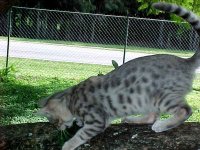
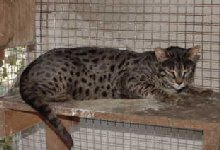
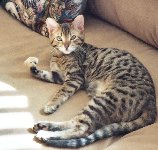
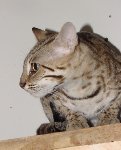







Originally christened the Leopardette and referred to by some authors as the Bengali. Bengals originated from a cross between a wild Asian Leopard cat and a domestic cat. A second Bengal originated with the Amur Leopard cat being used as the wild side. The Asian is known as the first cross for the Bengal. The Bengal is therefore considered a hybrid cat, and one would expect all the offspring to be infertile. Surprisingly, although the first male offspring did prove to be infertile, the females did not, and it was possible to use them in a planned breeding program to develop the new breed. At this point, the Bengal has been a breed for over 20 years so we are seeing much better Bengals. The reason is that we are able to use bengal females and males as foundation to bring additional Leopard Cat genes into the breed.
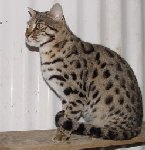

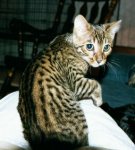

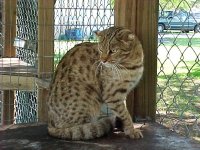

The history of the Bengal is believed that, over the centuries, there have been many mating between wild Leopard Cats in tropical Asia and the domestic cats taken to that region. But none of these hybrids were ever kept and developed as a special breed. Then, in 1963 an American geneticist, Mrs. Jean Sugden of Yuma, Arizona, crossed a female Leopard Cat, which she had obtained from a pet shop in the late 1950s, with a black shorthaired domestic male. A female offspring from this mating, named Kinkin, was then bred back to its wild father and this resulted in some plain and some spotted offspring. This could have been the start of a new, spotted breed, but the project was abandoned when Mrs. Sugden was widowed.
Then, in the late 1970s, Dr. Willard Centerwall, a geneticist working at the University of California, began a breeding program that involved crossing Leopard Cats with shorthaired domestic cats as part of a study of feline leukemia. Jean Sugden, now Mrs. Jean Mill following her remarriage, and living in California acquired eight female hybrids from Dr. Centerwall in 1981 and used these as the foundation stock for a new Bengal Cat project. As before, it was her aim to combine the markings of a wild Leopard Cat with the friendly temperament of the domestic cat. The female hybrids were mated with a red feral domestic cat that had been found living rough in the rhinoceros enclosure of Delhi Zoo, and a brown spotted tabby found in a California shelter. From these unlikely beginnings, the new breed of domesticated Bengal Cat was developed.
Several other American breeders were also active, and one in particular, Dr. Gregg Kent, was successful in producing crosses between a male Leopard Cat and a female Egyptian Mau. Other domestic breeds used from time to time included the Ocicat, the Abyssinian, the Bombay, the Siamese, and the British Shorthair.
In 1983 TICA accepted the domesticated Bengal Cat for registration as a new breed and it was first exhibited at cat shows in 1984-1985. It achieved National Championship status in 1990-1991.
By 1989 there were estimated to be about 200 Bengal Cats in existence. In the early 1990s some were imported into Britain, where their value was put at about $3,700 each, making them the most expensive domestic cat in the country at that time. Since then, with increased interest and further breeding, the numbers have risen dramatically and the initial high values have fallen. There are now thought to be as many as 500 in Britain and, according to a TICA estimate in 1995, there are at least 9,000 domestic Bengal Cats registered with cat clubs worldwide today.
The personality of the Bengal has terms used such as intelligent, agile, alert, active, athletic, cunning, curious, busy, powerful, determined, outgoing, social, loving, affectionate, confident, and independent. They are fond of water and have been known to jump into bathtubs to join their owners. They also love climbing and indulge in endless bouts of play-hunting. Their vocalizations differ from the ordinary domestic cat, containing several ?wild? elements.
The color of the Bengal range from marble, snow spotted, snow marble, sorrel (golden) marbles and spotted.
Enrichment: Variety adds to the stimuli for the animal, so providing safe plants, toys, and areas to climb will help with the overall well being of the cat. Also, housing the domestic cat with another cat of the opposite sex or same-sex if they have been brought up together and get along. This can add to the well being of the animal. Domestic cats do get along with several exotics and the exotic can be a nice companion.
Diet: A high quality processed food such as Nutro Kitten canned food has worked well for us. Also Excel, Royal Canin, Science Diet, Premium Edge, and Eukanuba. Our domestics also enjoy the turkey and beef raw with the Apperon Vitamins with Taurine and the Apperon Calcium.
When securing an animal from a breeder, don?t be afraid to ask for references.
If you would like to contact us:Cocoa
Home (Home Index)
(Colette Griffiths)
©2001 and beyond - All pictures are the property of Cocoa's Pride and not to be copied or reproduced